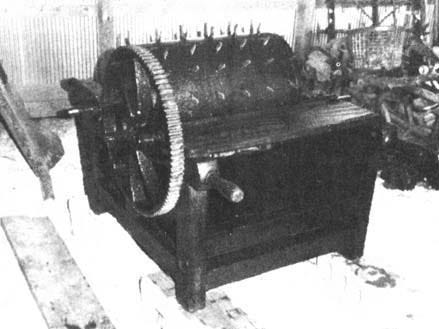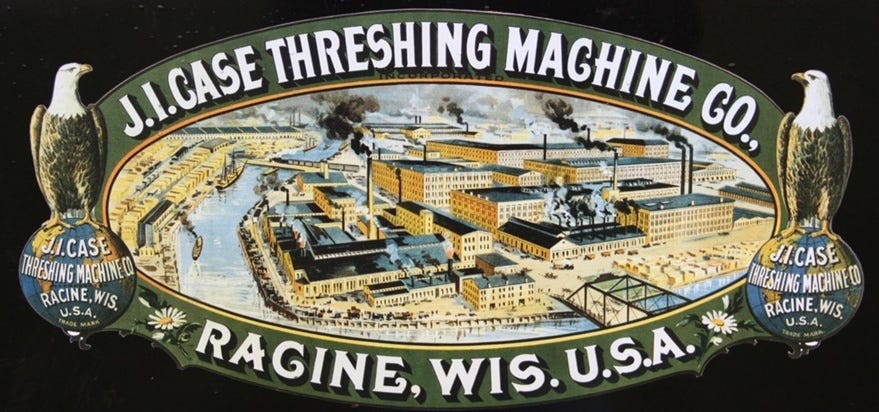Jerome Increase Case was born in 1819 in Oswego County, New York. He died in 1891 in Racine, Wisconsin.
One of seven children, Case did custom threshing in his youth. His father was a dealer for threshing equipment imported from England.
Case left New York in 1842 along with six “ground hog threshers” that he had purchased on credit. They were given the name “ground hog” because of their squat posture and from the rumbling and growling noises they made as they ground the grain. This earliest form of threshing machine was invented in 1788 by a Scottish millwright. It is a simple machine consisting of a spiked cylinder and fixed concave, cranked by hand, one man on each side. A third man fed the machine while a fourth was required to rake away the straw. The ground hog simply beat the grain from the heads, dropping the grain, chaff and straw to the ground. The grain still had to be basket winnowed to remove the chaff.
Rochester, in Wisconsin Territory, was Case’s destination when he left New York. Wisconsin gained statehood in 1848 having been a territorial possession of the United States since 1783 after the American Revolutionary War.
Case had learned that the country around Rochester was the wheat center of the mid-west, and he planned to make his career as a thresherman there. He began working to develop a machine that would more efficiently separate straw from the wheat kernels. To manufacture his machines, he planned to build a factory in Rochester but was denied water rights to set up a mill race and wheel on the Fox River. So, young Case loaded up his business and moved east to Racine on the western shore of Lake Michigan between Chicago and Milwaukee.
In Racine, Case rented a small shop and began to build crude threshers, improving them as new models were made. Each year the business grew and in 1847 Case erected a three-story brick shop that became the hub of his farm equipment manufacturing business. In tackling the centuries-old problem of threshing grain he had laid the foundation for the largest manufacturing concern of its kind in the world.
Case operated the business alone until 1863, when he organized the firm of J. I. Case & Company.
Throughout the 1860s, Case had foreseen the need for a new power source for his machines. Until this time, the machines were powered by treadmill horsepower. Case envisioned a steam-powered thresher that would work faster and outperform the old horsepower method.
During the 1880s Jerome Case continued to make his presence known in his factories and to the farmers. His death at the age of 72 was caused by acute diabetes.
Case had interests other than improving and manufacturing farm equipment:
elected mayor of Racine in 1856, 1858 and 1860
elected to the Wisconsin State Senate in 1865
founded two banks in 1871
founder of the Wisconsin Academy of Sciences, Arts and Letters
president of the Racine County Agricultural Society
breeder of race horses on his Hickory Grove Farm
owned some Great Lakes ships, a winter home in California, a ranch in Texas and a stock farm in Kentucky
he and his wife had four children live to adulthood. Three other children died young.
Jerome I. Case was inducted into the Association of Equipment Manufacturers Hall of Fame.
References:
Wik, Reynold M. 1951. J.I. Case: Some Experience of an Early Industrialist. Wisconsin Magazine of History.
Wendel, Charles H. 2005. J.I. Case. 150 years of J.I. Case. Krause Publications.
Pripps, Robert N. 2018. Who was J.I. Case? Farm Collector Magazine
The Company of Jerome Increase Case. racinehistory.com
Case, Jerome Increase 1819-1891. Wisconsin Historical Society.







